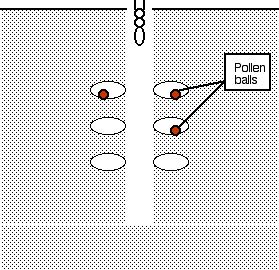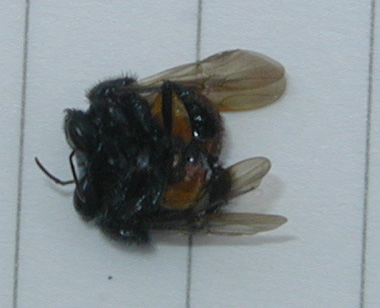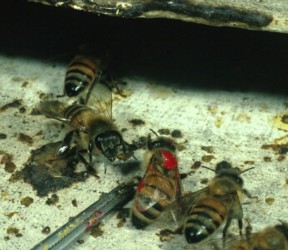The sweat bees. In many ways
these are the most captivating of the eusocial bees, because they are quite
common yet few people recognize them and even fewer know that they have
a social life. Sweat bees are in the family Halictidae, which are characterized
by having short-tongues, relatively small body size, and black, greenish-black,
blueish-black or green body color Most often their nests are burrows in
the soil.. If you watch at flowers during the summer in almost any temperate
habitat, you're bound to see several sweat bee species.
Sweat bees can live as solitary
individuals or in eusocial colonies, depending on the species. In the fall,
the next summer's reproductives emerge and mate. The males die and the females
find a safe place to overwinter. In the eusocial species the mated female
is called a gyne, and she becomes the queen of a colony the next spring.
When the gyne starts her colony she is alone and must do all the
work. She digs a burrow--a three or four millimeter diameter tunnel--in
the soil, excavates cells which extend from the burrow, provisions those
cells with pollen, and lays an egg on the mass of pollen in each cell. In
the eusocial species these eggs (usually there are 4-6) develop into females
who serve as the queen's workers. Once her workers emerge from the cells,
the queen's role is confined to egg-laying.
 |
Schematic diagram of a sweat bee nest. The bee, illustrated here guarding the nest entrance, has excavated a tunnel in the soil and has constructed six brood chambers, three of which have pollen balls. When each pollen ball is fully formed, the bee lays an egg on the ball and closes the brood cell entrance. In eusocial species this first brood of six will all be female workers. After larval and pupal development, the workers emerge and the queen continues to lay eggs in cells, which are now provisioned by the workers. |
|
Insert sweat bee image |
As the season progresses, sweat bee colonies grow to between a dozen and forty or so workers, depending on the species. The queen is marginally larger than the workers, but otherwise there is no difference between queens and workers (for more, see page on caste). One worker specializes in guarding the nest, and spends most of her time sitting at the nest entrance. Other workers are active in tunnel and cell excavation and in foraging. The queen maintains her reproductive advantage over the workers with overt dominance behavior, which is expressed by nudging them and refusing to let them pass her in the tunnel. The queen's size advantage may play a role in her ability to dominate the workers.
In some colonies the queen dies before the end of the reproductive season. One worker then establishes her dominance over the others and takes over the egg-laying role of the queen. Technically, this is not a eusocial colony, as it does not involve a queen and her daughters. When one female in a group of sisters dominates, the group is termed "semisocial". The importance of this comes from the changed pattern of genetic relatedness between the workers and the reproductive's offspring **link to haplodiploidy page**.
Apidae, long-tongued, includes most of the social bees, such as honey bees and bumblebees.
| Insert bumble bee image |
| (Left) Nest entrance of a common neotropical stingless bee, Trigona fulviventris. Thousands of worker bees and a single queen occupy this nest, which is constructed in a cavity in a large tree. Like many other stingless bees, T. fulviventris workers are quite territorial, vigorously defending both their nest and flowers where they forage. When a worker encounters a bee from another colony, they battle, locking jaws and falling to the ground. Fighting T. fulviventris rarely let loose; both bees eventually die. This level of self-sacrifice results in a colony that is well-defended, even though these bees lack a sting. | |
 |
More than ten other species of honey bee are known to science, and two of these species, Apis cerana and Apis florea, are also maintained in hives as honey sources by humans These other species are mostly found in Southeast Asia, but the ranges of some extend to India, China, and for Apis cerana, to Japan. The basic biology of all honey bee species is similar; the bees construct a nest using wax, a glandular product of the worker bees, as the primary construction material.
